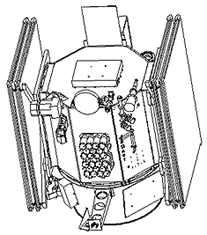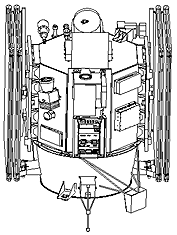Although
there are 12 advanced technologies on Deep Space 1, the rest of the spacecraft
is composed of current, low-cost
components that have been tried
and tested on other missions. (The Deep Space 1 flight computer, for instance,
is
based on that used by Mars Pathfinder and other missions.)
This approach was used because the focus of the New Millennium
Program is on proving that certain advanced technologies work in space,
not on building complete spacecraft representative
of those to
be used in future missions.
The spacecraft structure is
an aluminum space frame based on the three Miniature Seeker Technology
Integration (MSTI)
spacecraft built by Spectrum Astro, Inc. for
the Ballistic Missile Defense Organization. (Spectrum was the primary
industrial partner on Deep Space 1.) With most of the components
mounted on the exterior of the bus, their accessibility
simplified
replacement during integration and test.
The total mass
of the spacecraft as launch was about 486.3 kg, composed of 373.4 kg dry
spacecraft, 31.1 kg of hydrazine,
and 81.5 kg of xenon. The spacecraft
configuration is shown below.









